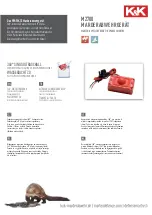
20
Landing
To land, fly down - wind past the landing area. Gently turn into the wind, add flaps
and reduce the throttle so that the airplane initiates an ascending glide path. If nec-
essary, add power to extend the glide path to reach the runway. As the model ap-
proaches and loses altitude, gradually and proportionally add “ up ” elevator
to control the glide path and altitude.
Continue to apply elevator until the mode l touches down at which time you should
be holding full, or nearly full up elevator. This will cause the airplane to slow and
settle to the ground.
Later, once you have become more experienced with your plane, you can cruise
around and perform slow “ fly-bys ” with the flaps extended.
CAUTION: If, during a rough landing, the propeller becomes jammed
and cannot rotate, the battery and speed control will become very
hot if you attempt to add power .
Immediately move the throttle down to stop the motor. If you fail
to do this, the motor, speed control and /or battery will be damaged.
After flight
Disconnect the battery and remove it from the airplane. Then, turn off the transmit-
ter. Allow the battery to cool before recharging, or allow the motor to cool before inst-
alling another battery for the next flight. Inspect the airplane to make sure nothing
has become loose or damaged.


































